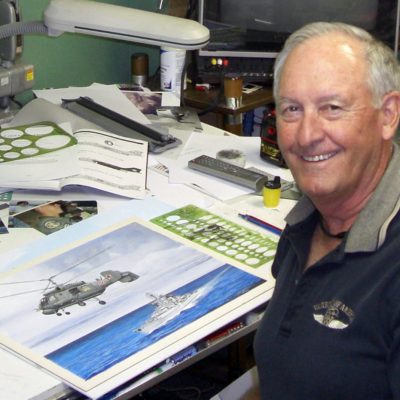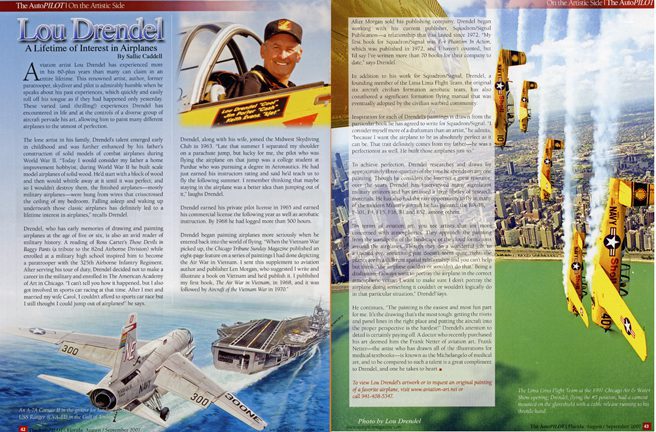The Artist


Lou Drendel
“A Lifetime of Aviation Art” on the home page tells about my professional career in aviation and aviation art. On the personal side, I have been married to my beautiful wife Carol for 58 years. We have 3 children and 7 grandchildren. We retired to Florida in 2003 when Carol convinced me to buy a 1926 historic home in the historic Venice community. I am an avid golfer (I can still shoot my age) and I divide my time between writing, painting, and golf. I have not flown an airplane since 2006, and yes… I still miss it!
My aeronautical passion was briefly sidetracked into the world of sports car racing when I bought my first Corvette and then met my future wife. Two years of road racing, and one wedding later, I was sans Corvette and getting serious about painting airplanes. Soon enough, I was also serious about flying them……but not before a return to falling out of them. Carol and I joined a skydiving club and spent one summer with the Midwest Skydiving Club. Fortunately for us, the primary jump plane pilot got his instructor rating that summer and offered to teach any interested skydivers to fly.

The article shown here appeared in the AUTOPILOT magazine. It featured a picture I took during the opening maneuver of the 1997 Chicago Air & Water Show. My Pentax 3000 with 20mm lens was mounted on top of the glareshield, with a cable release running to my throttle hand so that I could fire off pix as I flew the six-ship loop. This was the best of the 15 frame sequence.
Timeline of Events
1972
My First Book
I met Jerry Campbell, owner, and publisher of Squadron/Signal Publications, in 1972. We established an enduring relationship. My first book for Squadron/Signal was “F-4 Phantom in Action”, published in 1972. It was followed at regular intervals by over 50 more books. (See Books by Lou Drendel.)
All this authoring and painting (not to mention raising a family) had led to a moratorium on flying, but when a beat-up T-34 showed up at our airport, and I found out that it was being sold to a just-forming flying club, I took an orientation ride and my interest in flying was instantly rekindled.
1974
The Mentor Flyers was Founded
The T-34 Mentor is one of the nicest flying airplanes ever built. It was designed to have the feel of a 1950’s jet fighter. The controls are relatively light and well-balanced, and it is fast enough and comfortable enough to make it a good cross-country airplane. And it was fully aerobatic! The Mentor Flyers was founded in 1974 as a fifteen-member group, but we did not fill the membership until the early 80s. During those early years we spent more time on restoration than we did on flying.
Late 1970s
River Rats
My early books chronicled the air war in Vietnam, highlighting the missions flown by fighter pilots against the densest air defenses in the history of warfare. In recognition of these efforts, I was inducted into the “Red River Valley Fighter Pilots Association, aka: “River Rats”….a singular honor, since membership had been restricted to those who had flown missions into this hellfire area.
1980's
Experimental Aircraft Association
The early 80s also saw the popularization of civilian formation flying. I was an early member of the national T-34 Association and quickly became a formation flying addict. The T-34 Association soon set the standard for large precision formation groups at the annual convention of the Experimental Aircraft Association in Oshkosh.
1980's
Co-Authored Formation Flight
A major part of this rise to formation prominence was the publication of our manual “Formation Flight”. I co-authored and illustrated the manual, and it has since been reprinted 3 times. “Formation Flight” was adopted by all civilian warbird groups sanctioned by the FAA to fly formation in airshow airspace.
1988
The Lima Lima Flight Team
Weekly formation practices soon began to expand the envelope of maneuvers, and within a few years we developed into a precision team, capable of formation aerobatics equaling the jet teams in the range and complexity of maneuvers. The Lima Lima Flight Team has performed in front of hundreds of millions of spectators, from coast-to-coast and border-to-border since 1988.
Three years ago, I accepted a commission to produce a series of paintings for American Flyers website, the national company which provides flight training for Private, Commercial, Instrument, and Instructor ratings. This series of paintings covers virtually the full spectrum of aviation history.
It was while I was developing the “famous aviators” series for American Flyers that I created the technique of “ghosting” the image of the aviator in the background, with his airplane in the foreground of the picture. This technique has provided the basis for most of the commissions I have undertaken for pilots… famous or otherwise.
1989
Elected to the Board of Directors
I was elected to the Board of Directors of the T-34 Association in 1980 and have served as President since 1992. I also served a stint on the EAA Warbirds of America board, from 1989-1994. My designs for the formation flying qualification patches are used by all civilian groups.
As interest in civilian formation grew, we developed a core of formation pilots in our flying club, the Mentor Flyers. This core group eventually began to acquire their own airplanes and by the mid-80s, we had six T-34s locally.
2003
Retired to Florida
Dividing time between golf and writing and painting. Produced more books for Squadron/Signal Publications and subsequently began the “Illustrated” series of books, published by Aviation Art, Inc

